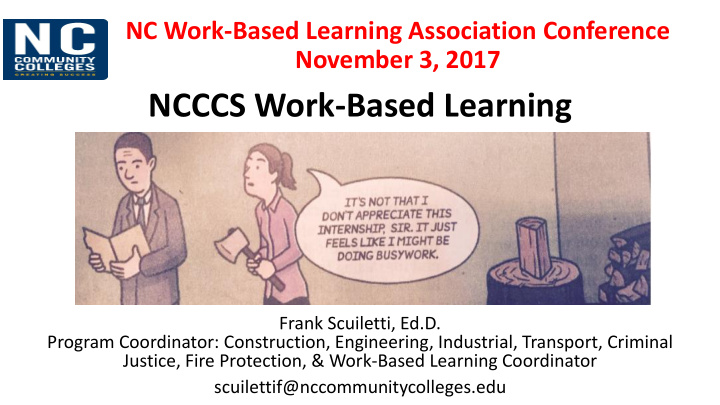



NC Work-Based Learning Association Conference November 3, 2017 NCCCS Work-Based Learning Frank Scuiletti, Ed.D. Program Coordinator: Construction, Engineering, Industrial, Transport, Criminal Justice, Fire Protection, & Work-Based Learning Coordinator scuilettif@nccommunitycolleges.edu
Amendment to State Board Community College Code (SBCCC) 1D SBCCC 400 - Curriculum • Memo CC17-050 dated October 23, 2017 • Effective November 1, 2017 Updates reflect 2014 Comprehensive Articulation Agreement revisions and Work Based Learning by the State Board of Community Colleges in 2013.
WBL Definition Work-Based Learning is the development of job skills and an opportunity for career exploration by providing the non-captive or non-special credit curriculum student with employment that is coordinated with the educational program.
WBL & Allowable Hours in AAS Programs • Credit of one semester hour per 160 hours employer- supervised work. • Certificate: Two semester hours credit max. • Diploma: Four semester hours credit max. • Associate in Applied Science: Eight semester hours credit max.
Allowable WBL Hours in Other Programs • Associate in Arts, Science, Engineering and Fine Arts in Music, Theatre and Visual Arts: Maximum of one semester hour credit which may be utilized as the 61st hour. • Associate in General Education: Maximum of seven semester hours of credit. • Associate in General Education Nursing: Work-Based Learning shall not be included.
Required WBL Components • Faculty coordinator/WBL director shall plan and coordinate student activity in WBL. • Employer responsible for student supervision. • If Work-Based Learning curriculum course required for program completion, course must be included in SO-approved program of study. • Students shall meet age/employment requirements (.) established by the State’s Apprenticeship Program. • A college shall utilize WBL course information as listed in Combined Course Library. • Consultation must occur during the WBL experience. Student must receive one mandatory site visit for consultation by college faculty/WBL director. Alternative methods may be utilized. • Students enrolled in Work-Based Learning curriculum courses must be enrolled in an approved curriculum program which includes WBL prefix curriculum course(s).
WBL Student File Colleges must retain the following: • Current student transcript or Final Grade Report; • Student time/wage report worksheet; • Completed Work-Based Learning application; • Measurable learning outcomes (MLOs) worksheet or a job description. • Documentation of an employer evaluation; and • Documentation of employer consultation.
WBL Budget Full-Time Equivalent (FTE) • Work-Based Learning curriculum courses shall earn budget/FTE at the 100 percent rate of assigned Work-Based Learning hours and shall not exceed a maximum of 320 membership hours per student per semester. • Students shall meet class membership requirements and shall also begin the Work-Based Learning experience before a college may claim class hours for budget FTE.
Membership or Contact Hours The college may report WBL as membership or contact hours if: • Enrolled as evidenced by payment of applicable tuition and fees, or obtained a waiver as allowed for in G.S. 115D-5(b); attended one or more classes prior to or on the 10 percent point in the class; and has not withdrawn or dropped the class prior to or on the 10 percent point. • Contact hours. Students may begin and end the WBL at any time during the semester or term enrolled. The college reports only the contact hours that the student actually worked within the term. • If college chooses to offer WBL orientation, 2 contact hours max of WBL may be counted toward student’s WBL hours. Orientation may occur prior to the beginning of the semester (although those hours may not be counted towards FTE) provided that the college has a written policy for such services.
WBL & Registered Apprenticeship • Increased from 8 to 16 SHC (AAS). • Increased from 4 to 16 SHC (Diploma) • Certificate: No change (2 SHC). • A student enrolled in a WBL course may utilize the course experience towards the on-the-job training component of the apprenticeship program (enrolled in a NCCCS CTE Program).
Local WBL Course Suffix Colleges may add a local suffix to the course number, if needed, to indicate sections if several programs include the same WBL course number. Colleges may also add a program descriptor to the title, such as "Work-Based Learning I- Welding“.
WBL Resides in a Broader Universe • Consider WBL policies (Section 20 CPRM/SBCCC) • Consider the broader universe that envelops WBL Curriculum Courses Curriculum Programs State/Federal Employment Laws/Title IV/Regulations College Policies (local) Credentialing Policies Registered Apprenticeship (RA) Career and College Promise (CCP) Employer Requirements
Recommend
More recommend